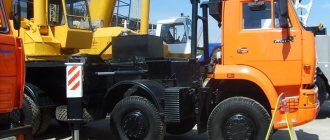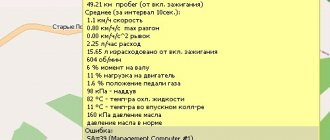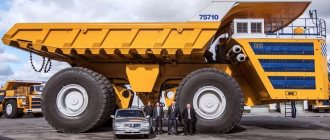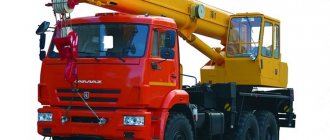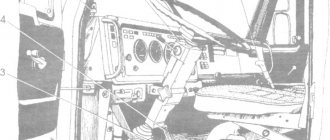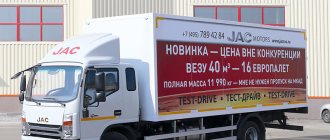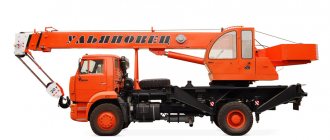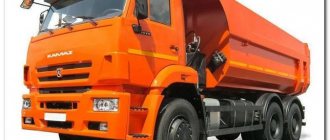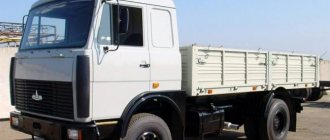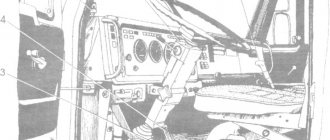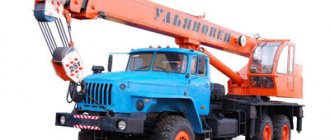Cargo "centipedes" from Holland
K. Timonin
In small Holland, there has long been a struggle to increase the territory that is being reclaimed from the sea. From decade to decade, the coastline deepens into the expanses of the ocean, providing the population with new opportunities for cultivating agricultural crops on coastal lands, usually blown by gentle winds and washed by the warm waters of the Gulf Stream. The enormous volume of soil transport carried out during “combat operations” required appropriate vehicles, highly efficient in operation and well adapted to local conditions. This is how a whole direction in the country’s mechanical engineering arose, associated with the production of especially powerful super-heavy on-road and off-road chassis, dump trucks and tractors; fortunately, the country’s legislation limits the total weight of road vehicles to a much larger value than in most European countries - 60.0 tons.
A feature of such vehicles, supplied to transport companies by two competing companies GINAF Trucks BV and Terberg-Benschap BV, is multi-axle, due to the need to reduce the load on each axle to the limits permitted by law. The requirement for high vehicle maneuverability has given rise to a variety of chassis kinematics with different types of steering and original steering mechanisms for steering wheels on different axles, previously unheard of in the global automotive industry. Special balancing suspensions were also developed, including those with hydropneumatic elastic elements, heavy-duty frames, steered and driven axles and other units that made GINAF and Terberg brand vehicles unique in their own way.
In Russia they are still practically unknown, but the desire of companies to go beyond the national market indicates that soon our compatriots, specialists in the field of transportation of bulk soil, will be able to get acquainted with them. It should be noted that the range of models produced by these companies is steadily expanding, and the experience accumulated by the designers allows them to offer machines for an increasingly wide range of industries, in particular for logging enterprises, port facilities, terminals, warehouses, and transportation of large-diameter pipes in areas without roads. Let's take a closer look at each of these companies and their products.
GINAF Trucks B.V.
This company, which was initially called “Gebr.Van.Ginkel” (“Van Ginkel Brothers”), began its activities in the 50s by reworking ready-made truck chassis in accordance with the needs of builders. These were mainly heavy American trucks, the gasoline engines of which were replaced with diesel engines, and the bodies were redesigned. The first self-developed dump trucks on the DAF chassis were released in 1966. The following year, the company changed its name and became known as GINAF. In 1976, it was the first in Western Europe to begin producing a four-axle dump truck with an 8x8 wheel arrangement, and in 1984, for the first time in the world, it began supplying the market with five-axle dump trucks with a 10x4 and 10x8 wheel arrangement, with the gross vehicle weight reaching 58.0 tons.
Since 1986, the company has equipped its cars with a unique hydropneumatic suspension with an adjustable roll angle. In 1991, another interesting new product appeared in production: an electronically controlled steering drive, which turns not the wheels, but the entire beams of bridges with a 1.8 m track under the frame using special longitudinal rods, which simultaneously play the role of hydraulic cylinders. The length of each rod was also electronically regulated. The world had never seen anything like it then.
The control effect in this design depended on the speed of movement. Considering that “bridge steering” is especially necessary when maneuvering, the system fully performed its function up to 20 km/h. From a speed of 20 km/h, the turning effect gradually decreased, and when reaching 45 km/h the axle was locked, becoming uncontrollable. This solution, which made it possible to radically improve the maneuverability of multi-axle “centipedes”, sharply increased the competitiveness of the machines.
To ensure maintenance of its cars (and the geography of their exports expanded from year to year), the company was looking, and not without success, for a partner with a developed network of repair stations. DAF became such a partner. Its dealers took on the troubles of servicing and repairing the GINAF chassis. Cooperation is taking place on some technical issues, as well as in the field of sales. Moreover, since the DAF program does not have all-wheel drive vehicles, GINAF complements its range with vehicles with wheel formulas 4x4, 6x2, 6x6, 8x4, 8x8, 10x4 and 10x8. The buyer can choose any car from those presented in the voluminous consolidated catalog of cars, equipped with a special body or in the form of a chassis.
GINAF production at the Fesnendaal plant is carried out only on orders. The modular principle allows you to quickly design and manufacture a car, even if it is not in the catalogue. The company can build a unique sample in a single copy, entirely created according to the client’s order. The company's annual production in recent years has ranged from 250 to 300 machines. Almost all models are equipped with DAF cabs and power units, and GINAF independently manufactures special frames, suspensions and axles.
The GINAF model range for 2003 is extremely wide. It is divided into basic chassis and special equipment, which includes tractors for working with trailers and semi-trailers, transporting extra-heavy loads, equipment for police services, etc.
The most compact in the family are two-axle 4x2 trucks, production of which began at the end of 2003. Equipped with IVECO Eurocargo cabs and Tector engines with 210, 240 and 275 hp. C2121N VW series vehicles with a gross weight of 20.5 tons are designed for work in the city - as delivery vans, in the public utilities sector, etc. GINAF has never produced a car similar in purpose and performance. By entering a new field of activity, the company expects to gain a foothold in the light city car market, winning part of the market from competitors such as Mercedes-Benz, IVECO, MAN.
All-wheel drive two-axle vehicles are represented by the X2212L-X2223 families. Their total weight is from 18.6 to 23.0 tons. These machines are equipped with engines with a power of 340, 381, 428 and 483 hp. Basically, dump bodies are installed on the chassis of these families; they often carry excavator equipment or a laboratory body for various studies.
Three-axle chassis with a 6x4 wheel arrangement are represented by the X3232S and X3233S series with a gross weight from 32.0 to 33.0 tons with diesel engines with a power of 249, 310, 340, 360, 428 and 483 hp. A special feature of these cars is the presence of a third drive axle, which rotates under the frame using hydraulic cylinders. Scope of application: urban management, construction.
Construction all-wheel drive three-axle dump trucks are supplied with bodies mounted on the X3326L-X3335S chassis. The total weight of these machines is from 26.1 to 34.5 tons. Engine power is from 340 to 483 hp.
Dump truck chassis with an 8x4 wheel arrangement of the X4241S and X4243TS series have high maneuverability, since the wheels of both front axles are steerable, and the rear axle turns under the frame when maneuvering. The cars are designed for a total weight of 41.0 to 43.0 tons and are equipped with diesel engines with a power of 381, 428 and 483 hp, their drive axles are the third and fourth, rotary.
Heavier 8x6 dump trucks are represented by the X4345TS and X4345TSV series. Their total weight reaches 44.5 tons, and the power of the installed diesel engines is 428 and 483 hp. Their all-wheel drive versions are designated as the X4446TS series.
Five-axle vehicles with a gross weight of up to 50 tons are produced with a wheel arrangement of 10x4, 10x6 and 10x8. Accordingly, the base chassis of these families are designated X5250TS, X5350TS and X5450B. The high maneuverability of these vehicles is achieved by a steering system with steered wheels of the first and second axles together with the rotation of the rigid beams of the third and fifth axles.
Special trucks
Specialty custom trucks include fire trucks, riot control trucks, military trucks, garbage trucks and airport fuel trucks. Several GINAF trucks also compete in the annual Dakar Rally, both as rally and utility trucks, and have done so since 1987, although the first GINAF to compete in the rally was designated as a DAF for marketing purposes. The number of GINAF trucks participating in the rally has been growing since Dutch driver Hans Becks entered a newly built GINAF truck in 2000.
Terberg-Benschop B.V.
Terberg-Benschop BV is the oldest branch of the Dutch Terberg Group. It traces its origins to a modest family rural forge-workshop, which laid the material basis for the enterprise, officially registered in 1869. The automotive line of business arose in 1948 due to the great need for transport for agriculture and construction. Terberg specialists, at a high technical level, converted large numbers of wartime army trucks of various brands into commercial vehicles, replacing their platforms, installing dumping mechanisms, and repairing their components and assemblies.
Soon, the Terberg brand firmly established its reputation as reliable and durable trucks that work effectively when transporting timber, in construction and in other sectors of the economy, and the well-established service department for these vehicles was especially noted.
In the mid-50s, the main direction of all subsequent activities of the company was formed - the creation of super-heavy off-road dump trucks, tractors and special chassis for installing various equipment, and instead of army trucks at this time they began to use standard DAF and Volvo chassis. Currently, original cars are assembled using cabs, units and components from Volvo, Meritor and ZF.
The modular design and flexibility of production in the only plant in Holland with an area of 30 thousand m2, where 200 people work, make it possible to bring products as close as possible to the requirements of a specific customer. At the same time, the demand for products bearing the Terberg brand is constantly growing. If in 1991 the plant assembled only four trucks a week, and in 2001 - 12, then in 2002 the assembly rate was already 14 vehicles, and there is every reason to believe that this is far from the limit. The range of products offered is constantly growing and currently includes about a hundred different models with wheel formulas 4x4, 6x4, 6x6, 8x4, 8x6, 8x8, 10x4, 10x6 and 10x8.
Thanks to the optimal distribution of weight along the axles in accordance with national road legislation requirements, the total weight of multi-axle dump trucks reaches 70.0 tons, and in terms of the payload/tare weight ratio they are leaders among competitors. The company's designers are constantly working to improve heavy-duty frames; driving, steering and drawbridges; as well as suspensions using rubber blocks, air springs and semi-elliptical springs as elastic elements. In 2003, a 6-cylinder 12-liter Volvo D12D diesel engine with a VEB engine brake is used as the power unit for all cars. Its power is 380 or 420 hp, and the gearboxes used are a manual 16-speed ZF Ecosplit or automatic, 4- or 5-speed Allison.
If in the 60s and 70s Terberg cars could only be found in the Netherlands, now they are exported to 80 countries around the world. To expand the geography of exports, car production was organized in South Africa and Malaysia. Since 2003, Terberg dump trucks have been officially offered on the Russian market, which has high hopes. In parallel with the production of dump trucks, the company mastered the production of low-loader chassis for garbage trucks, various terminal tractors, special pipe trucks and even tracked tractors.
The 2004 program includes three-, four- and five-axle families of trucks with tipper bodies, the most modest in terms of load capacity of which are the FM1350-WDG(L) with a 6x6 wheel arrangement and the FM1450-WDG(L) with a 6x4 wheel arrangement. The gross weight of the vehicles of these families is limited to 34.5 and 33.0 tons, respectively, and the design feature is a rear drive and steering axle with dual-pitch wheels, which in the basic version has a suspension with rubber elements. If desired, it can be replaced with an adjustable Dynalastic balancer with a single pneumatic element for each pair of wheels on one side.
The four-axle series of heavy vehicles with a gross weight from 44.0 to 46.0 tons is represented by the FM1850-T (8x4), FM1950-T (6x6) and FM2000-T (8x8) families. All of these vehicles have steering wheels on the first, second and fourth axles, a raised second axle and air-adjustable suspension on all axles.
Five-axle vehicles with a gross weight of up to 62.0 tons are designated FM3000-T (10x8) and FM2850-T (10x4). They are distinguished by the presence of a rear non-driving axle, which is raised above the road surface during empty runs.
